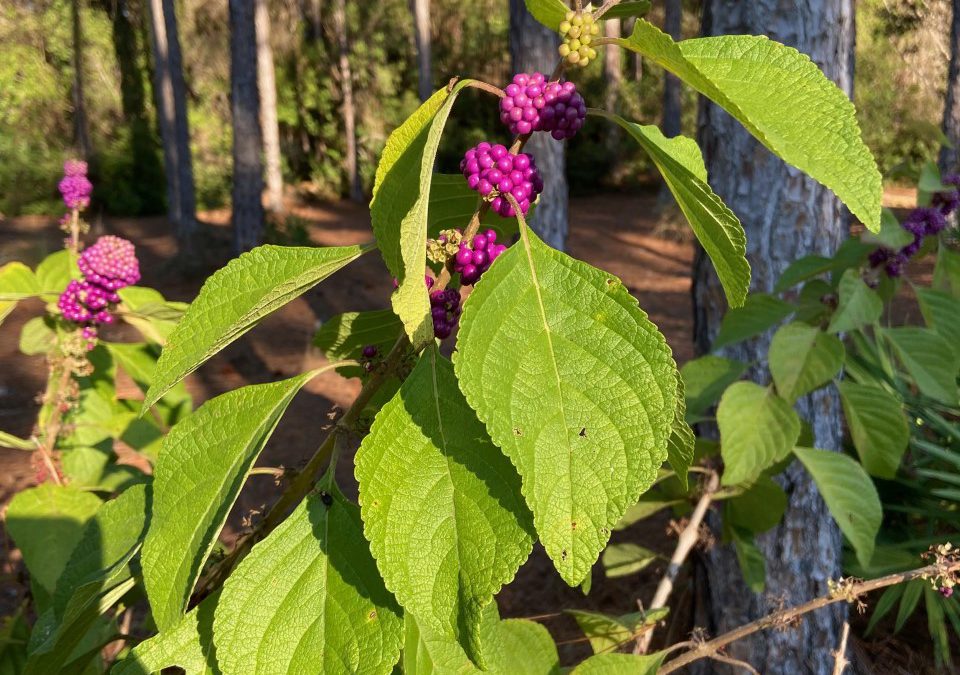
by Stephen Greer | Nov 4, 2021
Many of the native plants in the Northwest Panhandle of Florida are often placed into landscapes as backdrop support plants. Many bring the solid green color to emphasis other colorful plants. What is often missed is the opportunity to see the fall color palate of these plants. Sometimes the easiest thing to do is travel to the nearest nursery to purchase annuals and perennials that come from all over the world and have been time tested to determine their invasiveness outside of planting areas and are determined to be at a minimal risk of colonizing outside of their intended planting area.
Native plants may not be in the thought process and are often overlooked for their exceptional color that can be a focal point in the landscape. Several native plants bring multi-colored leaves or flowers adding fall interest for all to enjoy. Let us take a moment and look at just a few of the plants that can be found in the Florida Panhandle that offer the many colors you may be looking to utilize in your landscape.
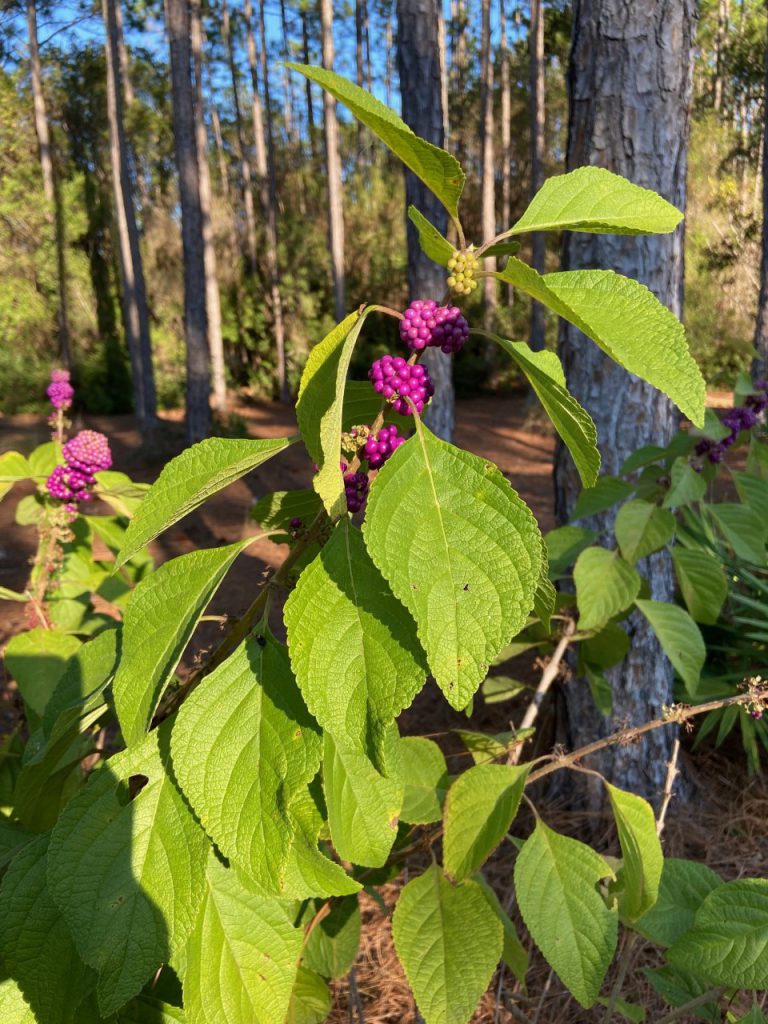
American Beautyberry (Callicarpa americana). Photo courtesy: Stephen Greer, University of Florida/IFAS Extension – Santa Rosa County
American Beautyberry
Beautyberry has two wonderful display times each year. In the late spring to early summer petite light colored lavender flowers open in small clusters along the upright stems of the plant. This flowering can be a brief soft show for a few weeks. The big color show comes in the fall with colorful shiny purple fruit clusters known as drupes. The fruit clusters around the stems of the plant in groups of 20 plus drupes. Often you will see multiple clusters on a given stem spaced approximately 3 to 4 inches apart in the beside the leaf petiole area.
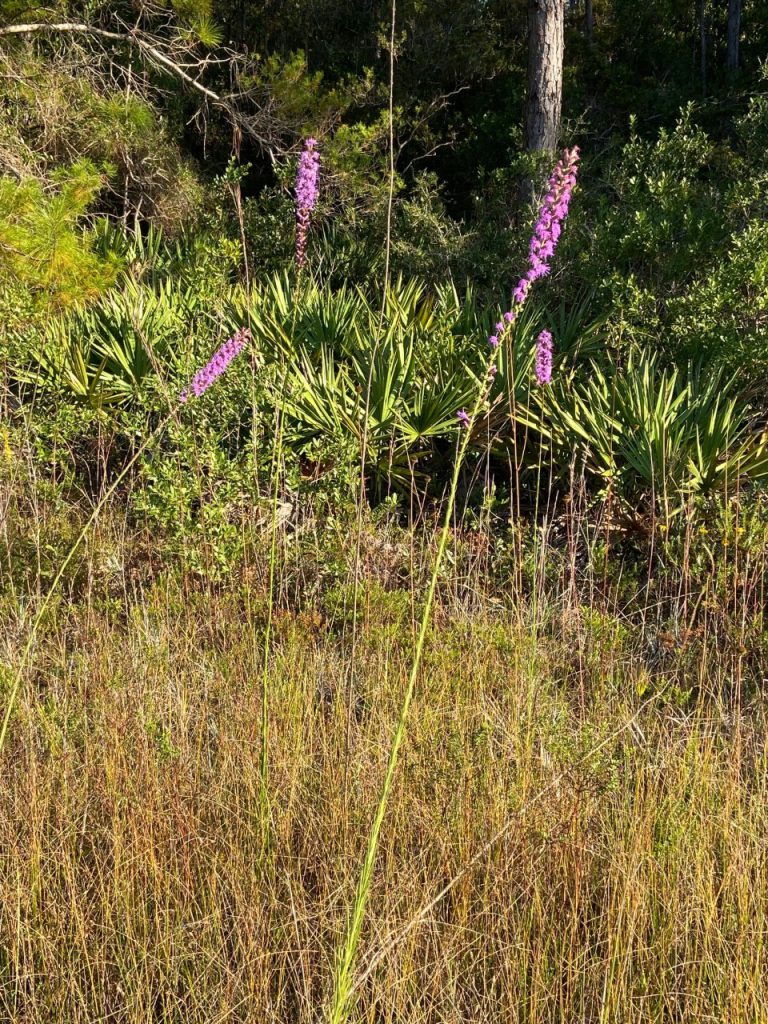
Blazing Star (Liatri spicata). Photo courtesy: Stephen Greer, University of Florida/IFAS Extension – Santa Rosa County
Blazing Star
Blazing star is another fall beauty that creates a great vertical flower floret display of tall spires showing a pleasant medium lavender color. The clustered small flowers provide color in the garden for several weeks. This pollinator plant attacks Monarchs and Swallowtails butterflies plus others adding more enjoyment to the garden. For quality establishment and growth, it needs well drained soil, yet soils that are not high in fertility. Overly fertile soils will over stimulate flower stem growth that will grow too tall and flop over. Blazing star can be divided once it is established and has expanded through underground stem growth creating a wider plant base. In sandy soil sites that have been disturbed through clearing this plant will often establish through seed from adjacent plant settings.
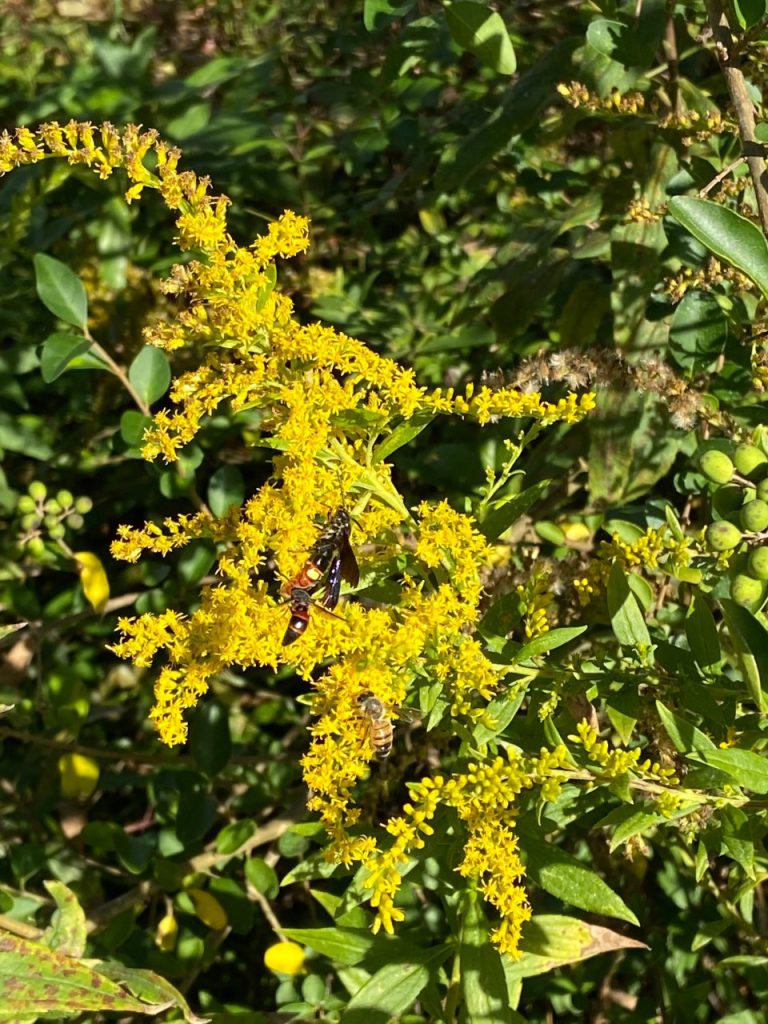
Golden Rod (Solidago spp.). Photo Courtesy Stephen Greer, University of Florida/IFAS Extension – Santa Rosa County
Golden Rod
One of the stronger colors of fall is yellow and the native Golden Rod is a big contributor with its upright stems holding multi-clusters of small bright yellow blooms. This plant serves as a pollinator plant for butterflies, bees and other beneficial insects. Often associated with fall allergies, this plant is not likely the culprit as the pollen is heavy and does not blow on the wind as ragweed will do. Ragweed blooms around the same time and does not have a showy bloom, yet many suffer from allergic reactions to this plant making it the likely problem plant for allergy sufferers. Golden Rod tends to colonize and crowd out other native plants so don’t hesitate to thin out the plant area if it is expanding too quickly.
Growing native plants including fall flowering selections is a fun journey for all to enjoy as the cool hints of fall weather moves in. Do a little research and keep in mind there is an Extension office in every county to assist in addressing your gardening needs.
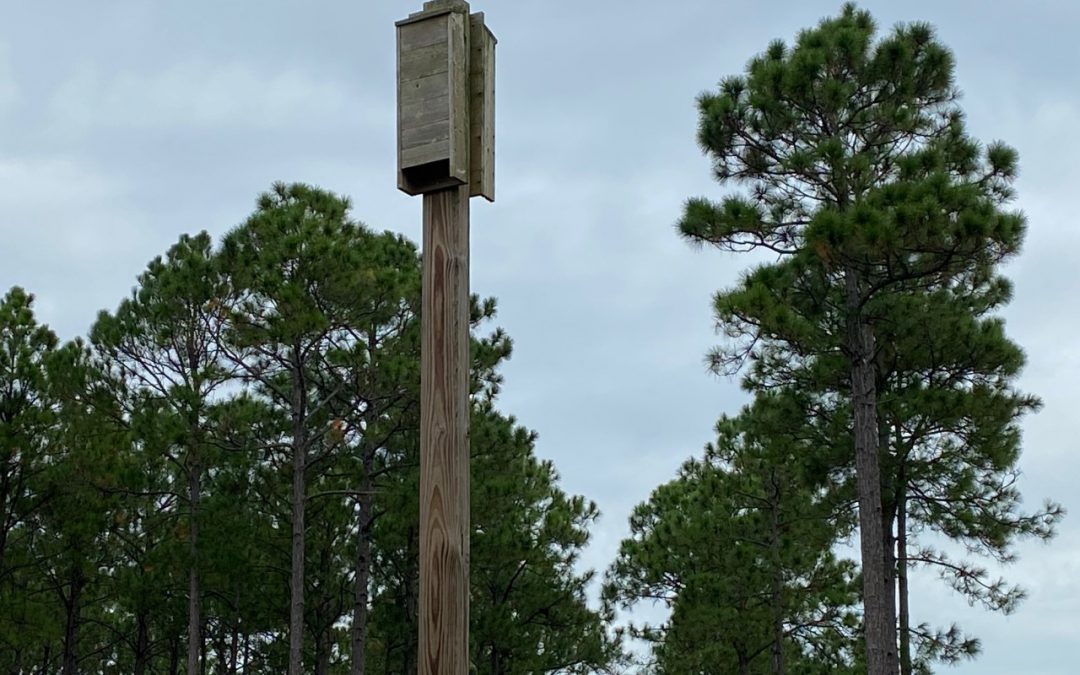
by Stephen Greer | Sep 16, 2021
Bats bring a beneficial component to your property and community. This flying mammal is an exceptional nocturnal feeder of many insect pests and they are important pollinators of many food plants. However, several challenges face this night flyer, like reduced roosting locations, reduced foraging sights, and over use of pesticides.
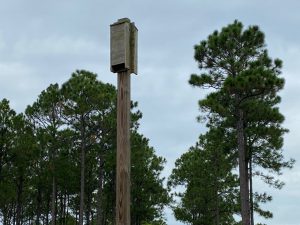
Photo courtesy: Stephen Greer
There are ways to attract bats to your backyard, farm, and community. Placement of bat boxes with ample water sources nearby is a good start. Water sources are another area of importance to attract bats. Have you sat by a swimming pool and witnessed a bat swoop down and skim across the water? It is likely they are either consuming a little water after feeding on a large number of harmful insects or are wetting their modified arms (wings) to help remove dust and dirt to reduce drag on their wings. Bats are the only mammal that are capable of true flight, the modified wings with skin spanning between specific bone structures allows them to accomplish this amazing action.
We often refer to bats as blind, but they can see shadows if out during daylight hours. This poor sight is not helpful enough for survival, this is where their echolocation abilities come into play. Humans studied bats to better understand how they make the sounds that bounce of an object and back to their sensing system that includes exceptional hearing. They locate and consume insects this way. If this sounds familiar, sonar systems were developed by studying this process.
Bats are the major harvester of night-flying insects, many that carry diseases that impact humans and other animals. Insect prey for bats include cockroaches, mosquitos, moths, beetles, gnats and others. A Big Brown Bat can catch and consume 3,000 to 7,000 mosquitos a night. Multiple this by a large bat population the amount of harmful insects harvested can go into the thousands of tons in a year. This is a positive impact for our forest and agriculture lands against major pests.
Florida is home to 13 different species of bats. They are always on the hunt for warm, dry, dark areas that are either natural or manmade narrow crevices. Out of all of these species, 4 bats are the primary inhabitants of bat houses. The Evening Bat and Brazilian free-tailed Bat are the most common in the panhandle of Florida. The Big Brown Bat and Southeastern Bat can at times occupy houses.
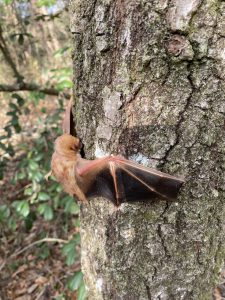
Photo courtesy: Matt Lollar
You can often locate bats boxes at your garden and agriculture centers or order online. Another option is to build your own boxes. Just remember the best way to erect a bat box is on a tall post. It is recommended to set the boxes around 10 feet off the ground. Placing boxes on trees creates a setting for potential predators to approach and feed on bats. Snakes have been known to enter and feed on young bats that are not fully developed and at best are poor fliers.
As a reminder, never touch a bat or any other wild animals. Bats that are healthy are not found on the ground, so assume the bat is not health and may be carrying a disease. On a final note, enjoy sitting on the back porch and watching the acrobatics of these amazing mammals in the evening sky.
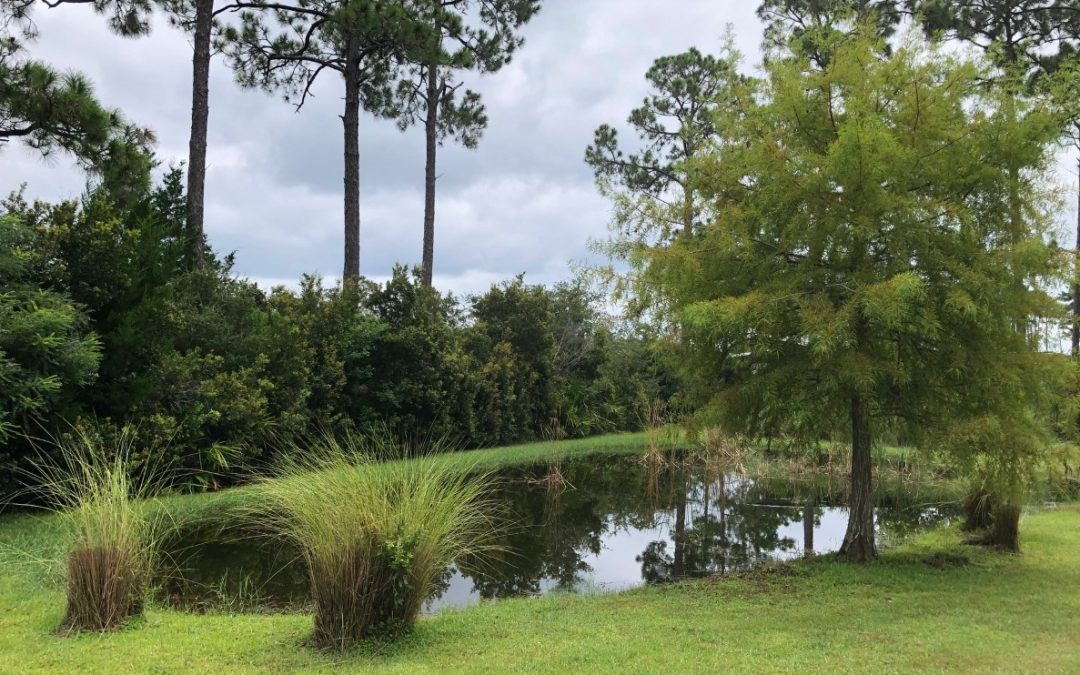
by Stephen Greer | Aug 11, 2021
One big goal of establishing a home lawn and landscape is to enjoy an attractive setting for family and friends, while also helping manage healthy soils and plants. Soil compaction at these sites can cause multiple problems for quality plants establishment and growth. Soil is an incredibly important resource creating the foundation for plants and water absorption.
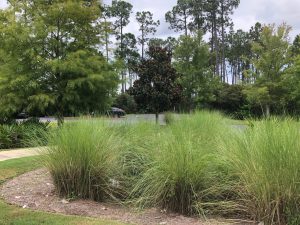
Photo courtesy: Stephen Greer, UF IFAS
Soils are composed of many different things, including minerals. In Florida, these minerals often include sand of differing sizes and clay in the northern area of the counties in the panhandle of Florida. Soil is also composed of organic matter, nutrients, microorganisms and others. When soil compacts, the air spaces between the sand or clay are compressed, reducing the space between the mineral particles. This can occur anytime during the landscape and lawn construction phase or during long term maintenance of the area with equipment that could include tractors, mowers, and trucks.
What can be done to reduce soil compaction? There are steps that can be taken to help reduce this serious situation. Make a plan on how to best approach a given land area with the equipment needed to accomplish the landscape of your dreams. Where should heavy equipment travel and how much impact they will have to the soils, trees, and other plants already existing and others to be planted? At times heavy plywood may be needed to distribute the tire weight load over a larger area, reducing soil compaction by a tire directly on the soil. Once the big equipment use is complete, look at ways to reduce the areas that were compacted. Incorporating organic matter such as compost, pine bark, mulch, and others by tilling the soil and mixing it with the existing soil can help. Anytime the soil provides improved air space, root will better grow and penetrate larger areas of the soil and plants will be healthier.
Even light foot traffic over the same area over and over will slowly compact soils. Take a look at golf course at the end of cart paths or during a tournament with people walking over the same areas. The grass is damaged from the leaves at the surface to the roots below. Plugging these areas or possibly tilling and reestablishing these sites to reduce the compacted soils may be necessary.
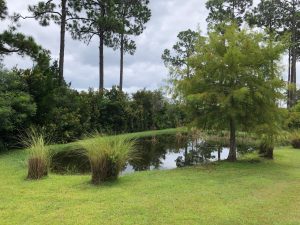
Photo courtesy: Stephen Greer, UF IFAS
Water absorption is another area to plan for, as heavy rains do occur in Florida. Having landscapes and lawns that are properly managed allow increased water infiltration into the soil is critically important. Water runoff from the site is reduced or at least slowed to allow the nutrient from fertilizers used for the plant to have more time to be absorbed into the soil and taken up by the plants. This reduces the opportunity for nitrogen, phosphorus, and other nutrients to enter water areas such as ponds, creeks, lagoons, rivers and bays. Even if you are miles from an open water source, movement of water runoff can enter ditches and work their way to these open water areas, ultimately impacting drinking water, wildlife, and unwanted aquatic plant growth.
Plan ahead and talk with experts that can help with developing a plan. Contact your local Extension office for assistance!
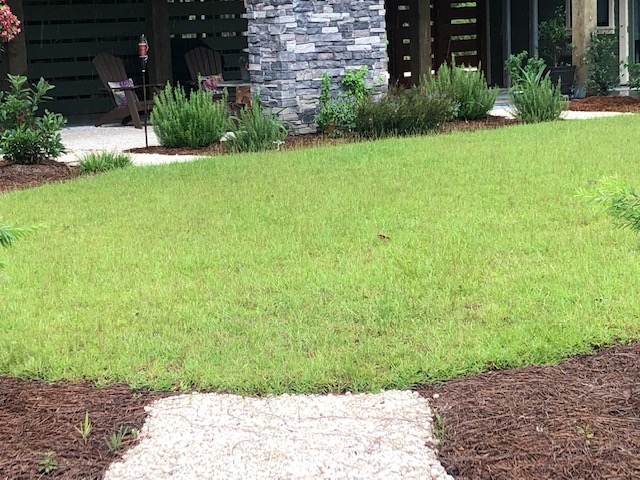
by Stephen Greer | Jul 1, 2021
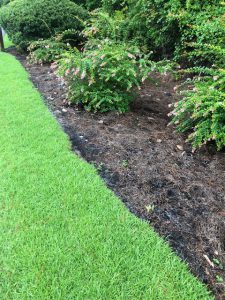
Photo Courtesy: Stephen Greer
Lawn areas come in all sizes and shapes. Some are large open expanses providing long views and others are smaller versions surrounded by shrubs and trees creating a more private and secluded setting. There are a number of reasons for reducing the size of a lawn with some coming into play with your decisions. A home lawn is often an important part of the landscape that provides a place to play outdoors from picnicking, tossing the ball to taking a quite stroll.
Maintaining a healthy lawn is important to an overall performance of this part of the landscape. Several factors are involved in the success in keeping a strong and resilient lawn. Understanding the needs of a grass to remain healthy involve soil testing to address soil pH and nutrient needs plus water challenges. Misuse of fertilizer and over irrigation can be costly to you and to the overall health of the lawn. These decisions can lead to reducing lawn size to managing cost or removing underused areas.
There are big benefits to reducing your lawn from saving time in mowing, trimming and other manicuring needs to saving energy costs involving the lawn mower not to mention reducing pollution from the mower or weed eater. The reduced amounts of pesticides needed to manage weeds and disease to the lawn saves time and money.
Another way to look at the reducing the size of our lawn is there will be more space for expanding plant beds and potential tree placement. These settings increase the opportunities for a more biodiverse landscape providing shelter, protection and food options for birds and other wildlife.
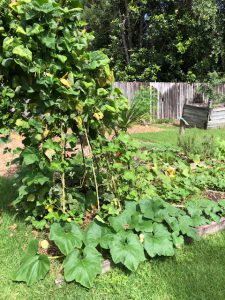
Photo Courtesy: Stephen Greer
The lawn can serve as a transition space that leads from one garden room space to another, while still offering a location to bring the lawn chair out to enjoy all that is around your lawn. Lawns and the landscape are ever changing spaces, especially as your trees and shrubs grow and mature to sizes that can directly impact the lawn performance. Often levels of shade will diminish edges and other areas of the lawn. This often will define the reduction of the lawn size moving going forward. Just remember that lawns and landscapes occupy a three-dimensional space involving the horizontal, vertical and overhead spaces. Just look around and think about what is best for you, your family and the setting.Are you more interested in developing other parts of the landscape? With many of us spending more time at home over the last year plus it gave time to think about the outdoor areas. Growing our own vegetables may be a new or expanding part of the landscape with the use of raised beds or interplanting into the existing landscape. Gardening can assist in reducing stress while at the same time providing that fresh tomato, lettuce, herbs and other fun healthy produce.
What ever your decisions are enjoy the lawn and landscape. For additional information, contact your local University of Florida IFAS Extension office located in your county.
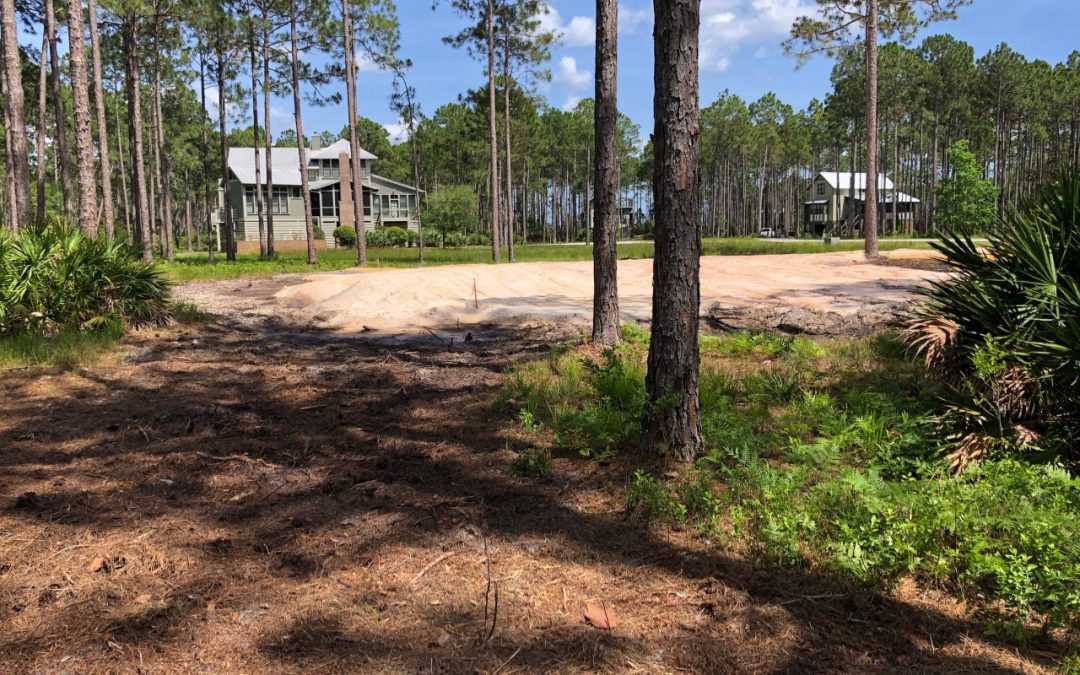
by Stephen Greer | May 27, 2021
As we have all observed communities are growing in the Panhandle through new home construction or through renovation of existing properties. This article will address new home construction. Many questions come to mind as construction begins with some of these questions needing to be addressed prior to start of construction. Determining impacts on the plant resources that already exist on the site should be included in the planning, design, construction and post-construction phases to be successful in achieving a healthy vibrant landscape for all to enjoy.
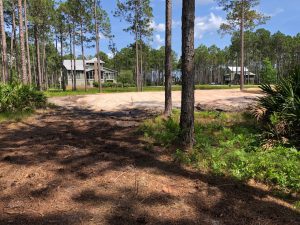
Photo Courtesy: Stephen Greer
Homes in community developments are being located on smaller lots in groups with conservation areas saved for the open spaces for all to enjoy. An older term for this was new urbanism and now is often referred to as conservation or clustered development. This type of development identifies and encourages environmentally friendly habitats for plants and animals creating a biodiversity within a walkable neighborhood designed to protect yet allow residence to enjoy some of the Northwest Florida beauty.
How can the objectives of building the new home desired, manage to protect the healthy plants already existing on the site? These challenges are difficult to answer but there are steps to accomplish both. For this article I will address construction and tree protection.
Protecting existing trees during the construction and post-construction phases takes expertise and a plan. First, consider hiring a professional arborist or urban forester to assist in this plan development. Understanding the existing trees on site prior to construction from the variety, location, visual impacts, size, overall health and location on the property are a good start. How do you protect the selected trees? First identify the trees that will need to be removed. Look for unhealthy stressed trees, significant limb death already occurring, poor crown growth (thinning) and other observations.
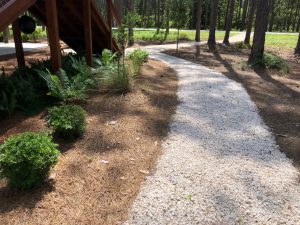
Photo Courtesy: Stephen Greer
The next step is to make a sight plan that needs to include grading needs for the home, drainage on the property, existing trees and surrounding vegetation, property lines, set back requirements, driveway location, utility placements and site of home. Flag trees that will be impacted and will need to be removed during the construction.
Following the sight plan, a tree protection plan needs to occur. This must happen before construction begins and include all parties involved to make sure all are in agreement. This is the stage where the group can identify conflicts involving tree protection and construction. Oversight by the owner, contractor and equipment operators is critical. A tree protection zone must be identified and implemented before construction. This typically involves setting up a fence around the protected trees and vegetation to restrict access of equipment and potential damage to the root system. A rule of thumb is to maintain a radius of at least 1.25 feet of protected area for each 1 inch of tree trunk diameter. An example would be a 12-inch diameter tree trunk with good protection at 15 feet to best protection at 30 feet of radius.
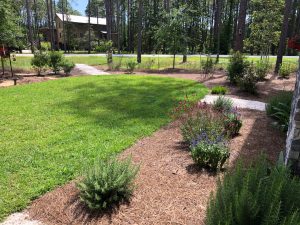
Photo Courtesy: Stephen Greer
The point is to give the best chance of a health survival of the tree during this soil and site disturbance as the construction process progress all the way to post construction with the removal of the protective fencing. Difficult decisions may need to be made of selecting trees to protect but will be needed. Enjoy the successes and plan for creating a new landscape that includes part of conserving plants that were there before and going forward.

















